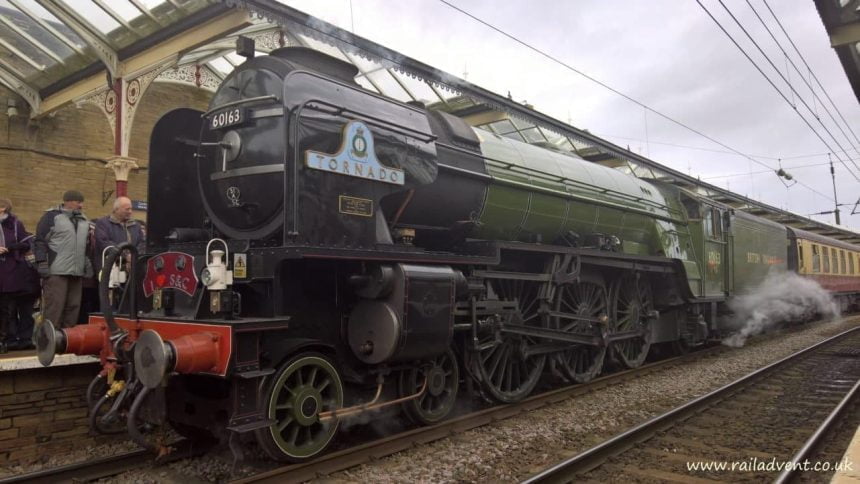The A1 Steam Locomotive Trust has released an update on the repair work taking place on A1 locomotive 60163 Tornado and what they think may have happened back in April.
The hope for a quick return following the failure of the valve gear on the Ebor Flyer on the 14th April did not happen for a number of reasons.
However, on the 6th October 2018, a DB Cargo steam examiner carried out an audit of the condition of the locomotive and the standard paperwork that accompanies it. This includes boiler certificates, testing of the axles etc.
No significant defects were found. In addition to the repairs to the inside valves and valve gear, the trust decided to refurbish and renew parts of the outside cylinder valve gear whilst the engine was out of service.
Arthur Stephenson Engineers Ltd of Atherton was able to forge and machine a new union link and combination lever in a short period of time for the inside valve gear. Durham Precision Engineering Ltd of Newton Aycliffe rapidly CNC machined a new crosshead drop link.
What may have happened in the first place?
One suspected contributor to the failure was the fit of piston rings, particularly, the gaps left between the ends of the rings to allow for expansion. These have been found to be a bit variable. However, the rings on the seized piston head were so badly damaged as to not be capable of measurement. The new rings have now been checked carefully that their ring gaps were correct in each liner.
The components that have been broken were put through a metallurgical investigation by Serco Railtest at Derby. The good news is that the failure of the combination lever was a typical ductile failure. This is to be expected of the soft metal that it is made of. The other fractures were consistent with the severe forces encountered by the now flailing combination lever and union link. The valve piston is estimated to have reached over 800°C (which is red heat) where it “picked up” in the liner. The materials of the piston head and rings were found to be to the correct specification.
Another contributor to the failure was lubrication. After the investigation, the key which transfers the drive from the ratchet mechanism to the lubricator camshaft was worn, this resulting in some lost motion.
When running fast, the momentum in the pump shaft prevented it from slipping backwards during each stroke which resulted in the higher output at speed. The inspection routine would not detect the wear in the key as it was only visible when the pump was running with the cover off the ratchet mechanism.
To overcome this, the maintenance procedure has been altered to remove and specifically check the condition of the key on an annual basis. The A1SLT does not feel like this would have been likely to contribute directly to the failure.
The ratchet fitted to Tornado since new has a single pawl. This pawl is a spring-loaded peg which engages in the teeth of the ratchet wheel to prevent it from turning backwards.
The trust has discovered that A4 Pacifics were fitted with a modified ratchet with three pawls acting on the wheel. This reduces the risk of the lubricator stopping if a single pawl fails – Tornado now has a three pawl ratchet.
Finally on lubrication, the oil extracted from the lubricator after the incident was found to be low in viscosity. No firm reason has been discovered for this. However, the trust are instituting an enhanced inspection regime on new batches of oil including carrying out viscosity tests.
In conclusion, The A1 Steam Locomotive Trust have found four contributing factors to the failure. Each one on its own would not have caused such failure, however, coming together, excessive rubbing between a ring or the valve head itself eventually resulted in localised heating which led to a thermal runaway causing the valve head to expand until it became locked in the liner. This, therefore, stopped the spindle moving which placed a great load into the inside valve gear which was absorbed by flexing the combination lever until it broke.
What did the officials say?
The A1 Steam Locomotive Trust said:
We owe thanks to the Nene Valley Railway which has made us most welcome and have gone out of their way to accommodate moves round the yard and the use of their railway to run-in Tornado. We are also grateful for the assistance of many other firms and individuals, including our loyal volunteers. Especially our sincere thanks goes to David Wright's Locomotive Maintenance Services Ltd of Loughborough and his staff, particularly Andy Morgan and Andy Meredith who have spent many hours at Loughborough and Wansford manufacturing new components, fettling existing parts and fitting them to the engine.
Where Next?
News Homepage
For the Latest Railway News
RailAdvent Online Shop
Framed Prints, DVD's / Blu-Ray's and more
LocoStop – The RailAdvent Community
Come and share your railway pictures
The A1 Steam Locomotive Trust
Visit their website


Dear Sir,
I’m a 77 year old Brit trained as a toolmaker and have been an active model engineer for 60 constructing 6 live steam passenger hauling locomotives in 3.5, 5, and 7.25 inch gauges. My father was a driver with the LMS out of Birmingham Saltley depo for 47 years.
The slipping ratchet problem with the lubricator is also experienced on a regular basis on live steam models also. I am a little surprised your engineers did not simply adopt the historic solution of multiple ratchets? I would assume you have done the same fix on the drive ratchet. I would also suggest that if not already in place, fit an oil feed sight glass in the cab.
The GWR (I may be wrong here!) used hydrostatic lubrication, which is a simpler system.
All the best,
Harold Pearson
+855(0)12812031
Phnom Penh
Cambodia.